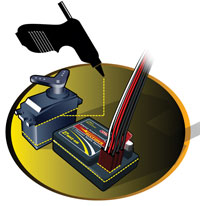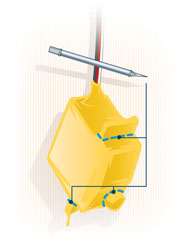

Off-season outdoor RC driving can be some of the most fun you can have with your rig. Ripping around puddles, jumping creeks, mashing through the mud, roosting a sand wave all over your buddies. Yeah! That’s what we’re talking about this month…vehicle protection for harsh conditions. With the right preparation, and some basic common sense, extending the RC mania through the late fall and winter is always feasible.

Completely sealing things up and using now readily available waterproof electronics will be your safest bet. The only downside is serviceability and operating temps. Wrapping electronics tight enough to keep out mud, snow and water means you will also be keeping in heat. This is something to be mindful of and requires frequent temp checks and even cool down periods. Cold weather running will make this a little less of an issue. Heavy mud can stick to the vehicle, loading a substantial amount of extra weight. This will also contribute to hotter equipment. Some RTRs come with waterproof gear already, and have been proven to hold up very well. If you’re waterproofing on your own, you’ll need to seal up all seams on your servos with silicon sealant or hot glue. Another option is to Plasti-Dip the servos. This is a liquid rubber product that comes in a can for dipping or aerosol for spraying. This does a better job than silicon products. Your receiver’s box can be sealed with silicon sealant. If your receiver is mounted directly to the chassis then you need to find a small plastic box with a lid that you can use to house the unit. Drill holes for wires and seal it all up with silicon. Motors may be able to be protected with a large balloon and zip ties. Bearings, axles and other metal parts are all at risk of rusting. There is not much you can do up front to prevent them from getting wet. All the care needs to be taken after the day’s fun. Make sure to gently hose off the heavy dirt and/or snow. If possible, use an air compressor to blow-dry the vehicle.

When you’re rig isn’t waterproof, you may find yourself driving with a bit more restraint, paying attention to the big puddles or really soggy mud. Carefully placed splash guards act as a safety net for when you get it wrong. Slide too far into the snow bank, or flip into the mud quickly and properly placed shields will save the day by giving your gear a fighting chance against the elements. Shields can be made out of body flashing or packaging materials. A simple piece straight across the leading edge of the chassis behind the front wheels will prevent a good bit tire gunk from getting to the innards. Think of a basic “Tub” that goes around the chassis and up to the body. A few crafty body manufacturers offer under and over tray options that work great but they are not available for all vehicles. If yours is not one of them, the shield can be mounted next to, or even onto the electronics themselves. Protect your exposed wires as much as possible. Some simple tape along the edges of your smaller harness wires, or case edges will do wonders. Pay close attention to any exposed servo leads and plugs.

Want to see more tips and product reviews? Get RC Driver Magazine? Subscribe Now!
The most important part of running in muck and moisture is the post run clean up. Don’t let the vehicle sit soggy. The gunk will hold the moisture and simply wreak havoc on your rig’s metal parts. Unplug the battery and give it a good hard shake to get all the big stuff off. If you have waterproof electronics you can gently hose it off as described earlier. Keep an eye on the drivetrain. Weeds, grass and slime will bind up your rotating parts quickly and will of course ruin the day of fun. An occasional drive by to check temps and give it a once over is the best way to keep the fun rolling.
Protect yourself and your transmitter. Now, this may seem second nature to most, but if your RC is having a hard time getting around, so will you. Don’t get so wrapped up in your RC awesomeness that you eat it on the way to your flipped truck, or slip on a rock and fall in the creek … Yeah, I um … Saw that happen to a guy one time … wasn’t me … swear. Watch for rain soaked trees overhead that could dump on you and your controller. Safety First Folks!
While there is no simple sure-fire way to make your RC 100% weatherproof, but with a little common sense, and tinkering time, you can protect you RC whip and still mash through the season change and still have a functioning rig come springtime.
 RC Driver The Best In RC Car & Truck News, Reviews & Video
RC Driver The Best In RC Car & Truck News, Reviews & Video 







